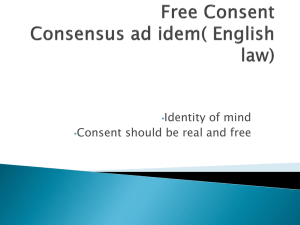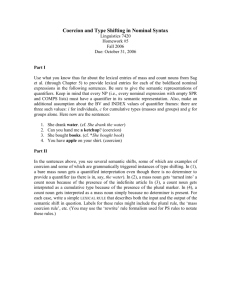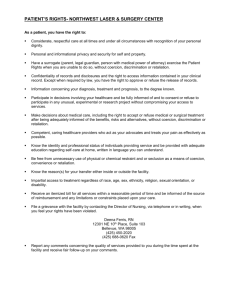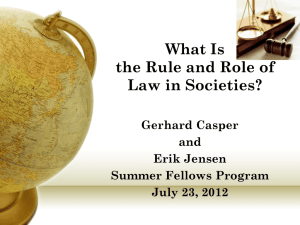understanding coercion
advertisement
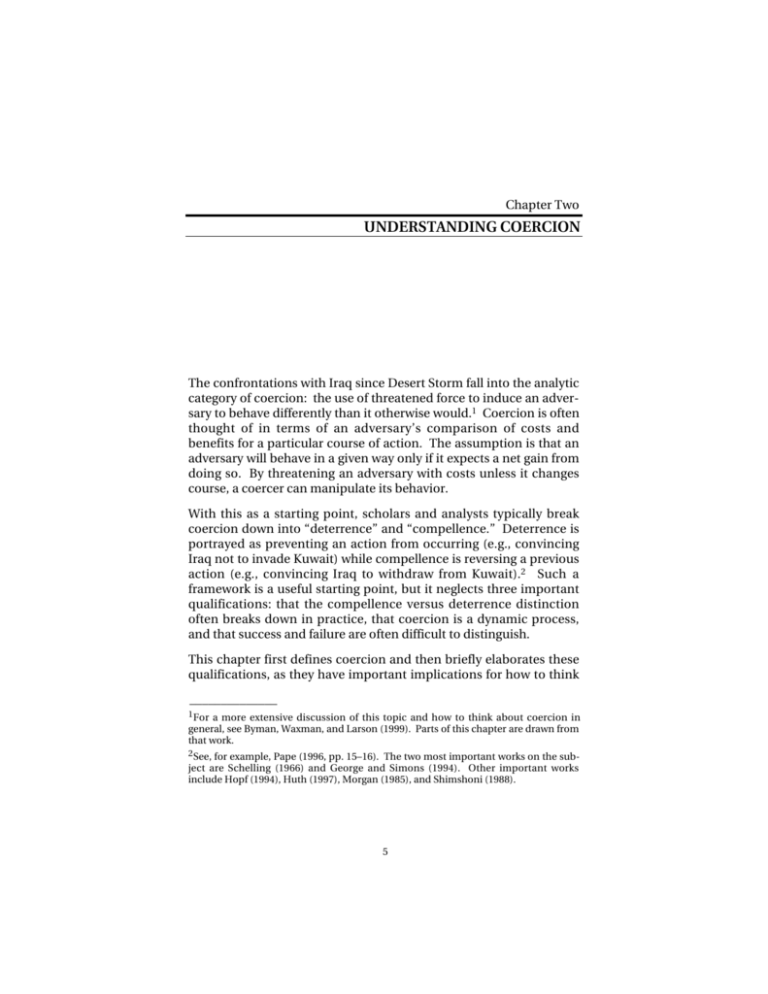
Chapter Two UNDERSTANDING COERCION The confrontations with Iraq since Desert Storm fall into the analytic category of coercion: the use of threatened force to induce an adversary to behave differently than it otherwise would.1 Coercion is often thought of in terms of an adversary’s comparison of costs and benefits for a particular course of action. The assumption is that an adversary will behave in a given way only if it expects a net gain from doing so. By threatening an adversary with costs unless it changes course, a coercer can manipulate its behavior. With this as a starting point, scholars and analysts typically break coercion down into “deterrence” and “compellence.” Deterrence is portrayed as preventing an action from occurring (e.g., convincing Iraq not to invade Kuwait) while compellence is reversing a previous action (e.g., convincing Iraq to withdraw from Kuwait).2 Such a framework is a useful starting point, but it neglects three important qualifications: that the compellence versus deterrence distinction often breaks down in practice, that coercion is a dynamic process, and that success and failure are often difficult to distinguish. This chapter first defines coercion and then briefly elaborates these qualifications, as they have important implications for how to think ______________ 1 For a more extensive discussion of this topic and how to think about coercion in general, see Byman, Waxman, and Larson (1999). Parts of this chapter are drawn from that work. 2 See, for example, Pape (1996, pp. 15–16). The two most important works on the sub- ject are Schelling (1966) and George and Simons (1994). Other important works include Hopf (1994), Huth (1997), Morgan (1985), and Shimshoni (1988). 5 6 Confronting Iraq about the U.S.-Iraq standoff and the practice of coercion in general. This chapter provides a conceptual framework for the empirical analysis that follows. DEFINING COERCION Coercion is the use of threatened force, including the limited use of actual force to back up the threat, to induce an adversary to behave differently than it otherwise would.3 Coercion is not destruction. Although partially destroying an adversary’s means of resistance may often be necessary to increase the effect and credibility of coercive threats, coercion relies on the future imposition of costs to move an adversary. In short, successful coercion is not war-fighting; the target in question still must have the capacity for organized violence, but choose not to exercise it.4 DIFFICULTIES IN DISTINGUISHING COMPELLENCE FROM DETERRENCE Coercion is typically broken down into two subcategories: compellence and deterrence. Compellence involves attempts to reverse an action that has already occurred or to otherwise overturn the status quo, such as evicting an aggressor from territory it has just conquered or convincing a proliferating state to abandon its nuclear weapons programs. Deterrence, on the other hand, involves preventing an action, which has not yet materialized, from occurring in ______________ 3 We use this particular definition to emphasize that, as elaborated in this chapter, coercion relies on the threat of future military force to influence adversary decisionmaking but that limited uses of actual force may form key components of coercion. Limited uses of force sway adversaries not only because of their direct destructive impact but because of their effects on an adversary’s perceptions of future force and the adversary’s vulnerability to it. There are, to be sure, many types of coercive pressure (sanctions, diplomatic isolation, and so on); unless specified otherwise, we use the term “coercion” to mean military coercion. 4 Coercion can be understood in opposition to what Thomas Schelling termed “brute force”: “[B]rute force succeeds when it is used, whereas the power to hurt is most successful when held in reserve. It is the threat of damage, or of more damage to come, that can make someone yield or comply. It is latent violence that can influence someone’s choice.” Coercion may be thought of, then, as getting the adversary to act a certain way by any means short of brute force (Schelling, 1966, p. 3). See also Pape (1996, p. 13). Understanding Coercion 7 the first place. Deterrence would include dissuading an aggressor from trying to conquer a neighboring state or convincing a country that desires nuclear weapons not to seek them. In practice, however, compellence is difficult to distinguish from deterrence and to separate from the overall security environment. Such haziness often leads to misunderstandings of the inherent role that compellence plays in deterrence and vice versa. While analysts and academics typically draw sharp distinctions between the two, in practice deterrence and compellence tend to blur, and both ultimately boil down to inducing the adversary to choose a different policy than it otherwise would.5 Classifying cases as compellence as opposed to deterrence is always speculative to some degree, given the inherent opacity of enemy intentions. And, ultimately, general deterrence and compellence are codependent, as success or failure in coercion affects the coercing power’s general reputation to some degree and thus its overall ability to deter.6 Figure 2.1 illustrates the difficulty of drawing clear lines between compellence and deterrence. General statements such as “don’t invade Kuwait” appear to fall clearly in the deterrence camp, while calls to withdraw would be obvious compellence cases. Yet the inbetween areas are more ambiguous. “Don’t go further,” involves both stopping an existing action and avoiding a future one. Moreover, a call to withdraw carries with it an implicit demand not to engage in the offense again and affects the credibility of the deterrence call not to invade Kuwait in the future. This is not to say that these analytic categories are not valuable, but rather to note that the categories overlap considerably in practice. ______________ 5 Some of these observations are elaborated in Schelling (1966, pp. 70–86). Although we argue that the compellence versus deterrence distinction blurs in practice, from a psychological perspective it is often harder for a leader or regime to give up something once they have made the effort to gain it in the first place. See Kahneman and Tversky (1979, pp. 263–291) for more on common decisionmaking biases. 6 For works on the reputation effects of deterrence and coercion, see Hopf (1994), Huth (1997), Morgan (1985), Shimshoni (1988), Bar-Joseph (1998), and Lieberman (1995). Evidence for the reputation hypotheses is mixed (see Huth, pp. 92–93). In general, the reputation effect is stronger when it involves the same countries or when the region in question is the same. 8 Confronting Iraq RAND MR1146-2.1 “Don’t do it again” Deterrence “Don’t invade Kuwait” “Cancel preparations to invade” “Don’t go/Stop invasion” “Withdraw” Compellence Figure 2.1—Deterrence and Compellence Blur in Practice The primary focus of this report is on the compellence subset of coercion, but given that deterrence is a highly related phenomenon (both use the threat of force to manipulate an adversary’s decisionmaking calculus), we incorporate insights and examples drawn from both subsets. We use the catchall phrase of “coercion” in the rest of this study. COERCION AS A DYNAMIC PROCESS There is a strong temptation to treat coercive threats as single, discrete events, failing to capture the dynamic nature of coercion. This static approach has led analysts to misunderstand causality, which is ultimately where military planners and policymakers most need insight from academics. Analysts instead should view coercive contests as series of moves and countermoves, where each side acts not only based on and in anticipation of the other side’s moves, but also based on other changes in the security environment. As noted at the outset, most standard explorations of coercion rely on an expected Understanding Coercion 9 utility model to determine whether coercion succeeds or fails.7 These models predict outcomes by comparing the expected costs and benefits of a particular action: coercion should work when the anticipated suffering an adversary associates with the threat exceeds the anticipated gains of defiance. This “equation” is useful for understanding the problem of coercion in the abstract, but it often confuses the study of coercion when taken as a true depiction of state behavior. One problem is that this equation fosters static, one-sided thinking about coercive contests. It encourages analysts to think about costs and benefits as independent variables that can be manipulated by the coercer, while the adversary stands idle and recalculates its perceived interests as various threats are made and implemented.8 A more complete picture requires viewing coercion as a dynamic, two-player (or more) contest. The adversary, too, can move to alter the perceived costs and benefits associated with certain actions. It can divert resources from civilian to military functions, for example, to offset a coercer’s attempts to undermine the adversary’s defensive capacities. It can engage in internal repression to neutralize a coercer’s efforts to foment instability. Rather than simply minimizing the effect of coercive threats, an adversary may try to impose costs on the coercing power. It can escalate militarily or attempt to drive a diplomatic wedge between states aligned against it, perhaps convincing the coercer to back down and withdraw its own threat to impose costs.9 Any assessment of U.S. coercion of Iraq should, of course, consider how U.S. threats injected perceived costs into Iraq’s decision calculus. But, viewing coercion dynamically, that assessment should also ______________ 7 In addition to Schelling’s work, a rationalist, cost-benefit approach is employed in many other major works on coercion, including Bueno de Mesquita (1981) and Achen and Snidal (1989). In his study of the effects of strategic bombing as an instrument of coercion, Robert Pape (1996, pp. 15–16) uses such a model. 8 Pape examines this briefly in his discussion of why Germany did not surrender in World War II. See Pape (1996, p. 256, especially Footnote 4). This point is also implicit in Pape’s discussion of how adversaries offset coercive pressure. For a summary, see Pape (1996, p. 24). 9 For an assessment of such strategies, see Byman and Waxman (1999). 10 Confronting Iraq consider Iraq’s ability to neutralize those costs as well as to impose costs on the U.S. and its allies. THE UNCERTAIN MEANING OF “SUCCESS” Studies of coercion often pay inadequate attention to the range of goals pursued by a coercer. Moreover, they typically employ absolute, binary metrics of success, where a coercive strategy either worked or it failed. Assessments of coercive strategies must shed these tendencies and instead consider a spectrum of possible outcomes. Classifying a case as a success or failure depends on the particular definition of the behavior sought in that case, leading to confusion when comparing different analyses of the same event. For example, in Operation Desert Storm the behavior sought from Saddam Husayn might have been Iraq’s picking up and peacefully retreating from Kuwait. Or, it might have instead simply been Iraq’s not being in Kuwait, one way or another. One might conclude that the air campaign successfully coerced Iraq to withdraw from Kuwait because Iraq was willing to withdraw by the end of the air campaign under conditions relatively favorable to the United States. If one instead assumes that coalition objectives were to induce Iraq to withdraw without having to forcefully expel it through the use of ground troops, then one could just as easily characterize the air campaign as a failure of coercion. The way in which the very issue of “success” is framed exacerbates this confusion. The use of absolute, binary terms does not capture the complex and often subtle effects of coercion. Iraq both conceded and defied the United States during Desert Storm. On the one hand, it offered a partial withdrawal from Kuwait as a result of the air campaign while, on the other hand, it refused to accept all U.S. demands. The straitjacket of binary metrics distorts the lessons we may draw from aggregated empirical data when cases in which U.S. threats helped move an adversary in favorable ways but short of maximal U.S. objectives are coded either as absolute failures or as absolute successes. At the same time binary metrics may bias studies of coercion one way or the other, they may also understate the detrimental effects of Understanding Coercion 11 coercive strategies. One of the greatest risks of coercion is its potential for backfire. Threatening an adversary may provoke an increase in unwanted behavior rather than the desired course. The 1967 Arab-Israeli War and the 1969–1970 Israeli-Egyptian War of Attrition are frequently cited examples of inadvertent escalation resulting from coercive threats.10 In Somalia, U.S. Army helicopter strikes on strongman Mohammed Farah Aideed’s subordinates not only failed to intimidate General Aideed but may also have provoked anti-U.S. sentiment, contributing to the demise of the American-led operation. In other words, coercive strategies can leave the coercer worse off than when it started. Yet within the binary framework, the worst outcome recognized is the null result: backfires and hardening of adversary resistance are coded just as if coercive threats had no effect. Conceptually, the dependent variable should be understood as a marginal change in probability of behavior. Against a fluctuating background level of threat (and blandishments, for that matter), the probability of the adversary altering its behavior is never zero. Viewing success in absolute terms, based on observed behavior, ignores this positive probability and classifies all desired behavior as “successful” coercion, regardless of how likely that behavior was prior to the additional coercive threat. Data limits may require a focus on observable behavior, but analysts should not forget that understanding coercion is ultimately about understanding the adversary’s decisionmaking process. This chapter has presented an analytic framework for understanding U.S. attempts to coerce Iraq since the end of Desert Storm. It argued that standard frameworks for understanding coercion, such as the distinction between deterrence and compellence and the use of simple cost-benefit models, are useful for heuristic purposes but often oversimplify a complex reality. It further argued that empirical studies should focus not only on U.S. coercive strategies but also on adversary counterstrategies to them. Taken together, these points suggest that successful coercion has as much to do with constraints on the coercer as with vulnerabilities of the adversary and that the balance of constraints and vulnerabilities can change over time. ______________ 10See Stein (1991) and Bar-Siman-Tov (1991). 12 Confronting Iraq Coercing Iraq is not only about threatening it with air strikes and sanctions, but also about the interaction of two political systems within a broader international context. The following chapters apply this expanded framework to the extended U.S.-Iraqi conflict both to further refine our theoretical understanding of coercion and to draw specific policy lessons to protect U.S. interests in the Persian Gulf.
